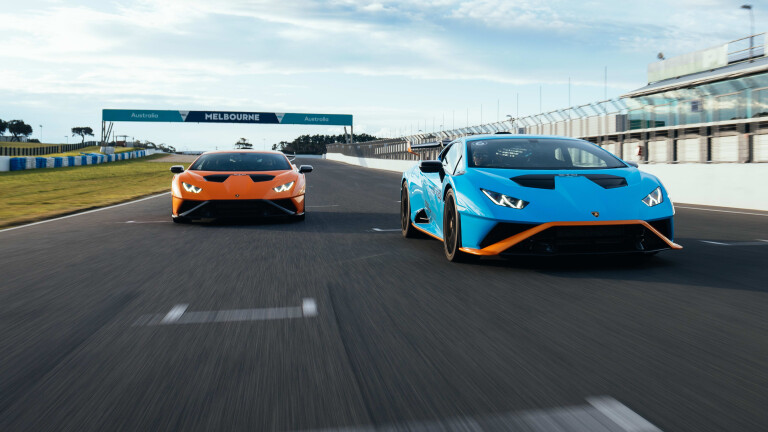
Score breakdown
Things we like
- Glorious, ear-drum-shattering V10
- Looks incredible
- The best-handling Huracan ever?
Not so much
- It’s sold out
- Focused chassis could be a handful on Aussie back roads
- Aussies miss out on excellent bucket seats
Road cars that transform into track-day specials tend to be humourless, serious things. They’re more about shaving tenths from your lap time and boosting mid-corner speeds than they are about having fun. Take the new Porsche 911 GT3 RS as an example. There’s no doubt it’ll be awesomely engineered and ferociously fast but could you ever imagine it cracking a joke?
“Ha! Zee only joke here, stupid human, is your inferior driving skill!” is about all it’ll offer.
Things are different at Lamborghini. This is the Huracan STO and it’s Sant’Agata’s take on the track car. STO stands for Super Trofeo Omologata and Lambo is pitching it as a road-legal version of its Super Trofeo racing car. Omologata translates to homologation, after all.
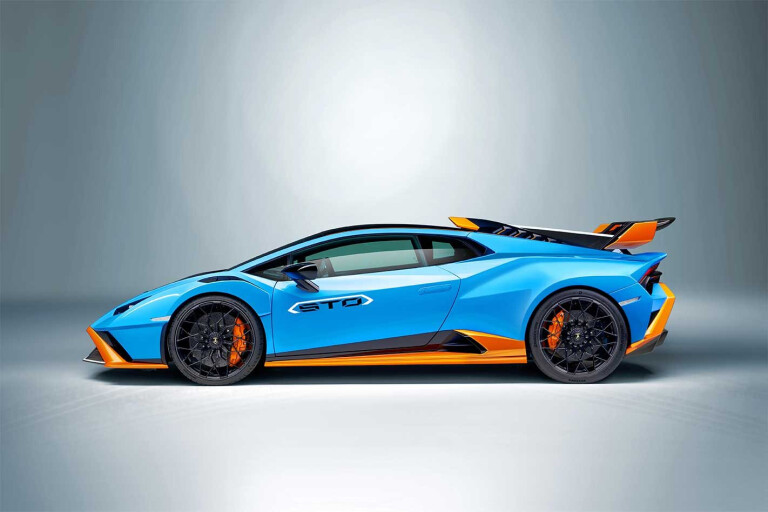
Just like the Porsche GT3 RS, the focus here is all about track work and lap times but steely-eyed? Humourless? Even sitting still, the STO looks hilarious. And vaguely insane.
Lamborghini had a fleet of STOs at Phillip Island for our brief drive and each one was an exciting riot of decals, eye-searing paint schemes, gulping roof-mounted air intakes and shark fins. Lambo doesn’t really do serious, does it?
Beneath all the visual drama, though, there’s some serious engineering at play. There’s less weight, it’s rear-drive only, downforce has been increased substantially and a new carbon braking system is fitted to ensure the STO is just as capable to drive as it is wild to look at.
Question is, has it worked? We ventured onto a wet and slippery Phillip Island circuit to find out.

Pricing and features
The STO serves as flagship of the current Huracan range and is priced accordingly. At $596,000 before on-road costs, it’s a whopping $212,000 more than an entry-level Huracan Evo – but you do score a lot more performance for your cash.
Its bodywork, for example, is now made mostly of carbon-fibre composite and the entire nose of the car – the bonnet, front splitter and front quarter panels – are now a single piece. Front-end bingles just got a lot more expensive…
All up, the STO is 43kg lighter than the brand’s last lightweight special, the Performante. The bodywork has been carefully honed and sculpted, too, to increase downforce. Huge fins adorn the top of the wheelarches, that central shark fin helps to direct air more cleanly onto the huge rear wing and the wing itself is manually adjustable through three positions.
The rear diffuser is also fiendishly complex and includes two enormous holes where you can see almost the entire width of each rear tyre. Speaking of which, they’re specially developed, road-focused Bridgestone Potenza Sports that measure 245/30 ZR20 up front and 305/30 ZR20 out back.
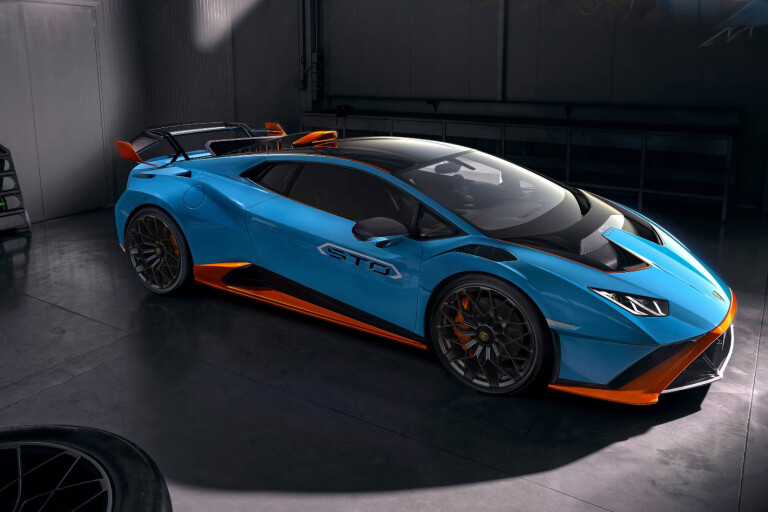
Stickier Potenza Race rubber is also available as an option, though it’s slightly odd that Lambo decided against fitting the more aggressive tyre as standard given the car’s track focus.
Regardless, the STO is an incredibly intricate and ferocious thing to run your eye over and it’s not just for show. The melee of flics, vents and strakes help to generate 450kg of downforce at 280km/h.
That’s not in the same league as the new 911 GT3 RS, which has almost double the downforce at the same speed, but it’s still a 53 per cent increase over a Huracan Performante (remember its intriguing ALA active aero system?) and it’s on-par with other rivals like the Mercedes-AMG GT Black Series.
As you’d expect, the suspension has come in for some serious alterations. Spring rates are up and there are new bushings and anti-roll bars. Track widths have grown, too, and the MagneRide 2.0 adaptive dampers have also been recalibrated to ensure the STO is as agile and as planted as possible around a circuit. How that impacts the STO’s behaviour on public roads remains to be seen. Our time was the car was strictly track-only.

One thing that hasn't changed is the engine. Lambo’s iconic 5.2-litre V10 is nestled behind the driver and it remains the star of the show. In the STO it makes 470kW at 8000rpm and 565Nm at 6500rpm, which is the same peak power as the Performante but slightly less torque.
Also carryover is the seven-speed dual-clutch gearbox, but Lambo’s engineers have tweaked the STO’s throttle map to be more aggressive. The soundtrack has also been massaged to boost the aural drama as you close in on the 8500rpm redline.
Oh yes, the noise. You’ll hear an STO long before you see it. This car is so loud that we can hardly believe it’s legal and the operatic howl it makes at full tilt is unlike any other supercar.
As for the key change Lamborghini is most proud of? That’ll be the brakes.

“STO is a very different car to drive to other Huracans but the biggest difference is the braking system,” says Lamborghini’s chief driving instructor, Milos Pavlovich.
“It’s got carbon brakes and we are really proud about this system. We have never had fading, long pedals or any problems after doing a lot of laps.”
Lambo calls the new brakes CCM-R and claims they can pull the STO from 200km/h-0 in 110 metres. Developed by Brembo, the carbon discs measure 390mm up front and 360mm out back and are said to offer 25 per cent more stopping power than a regular carbon set-up.
If all of this sounds bewildering, here’s an easy number to latch onto. Lamborghini claims the STO is nearly three seconds quicker around the Daytona International Speedway road course than the Performante. And it’s only 2.5 seconds away from the slick-shod GT3 Evo racer.

Comfort and space
If a richly specced and luxurious cabin is important to you, this isn’t the Huracan to buy. To save weight, the STO’s interior has been stripped back to its bare bones.
There are no carpets, cup holders or door bins. Even the windscreen is 20 per cent thinner to save some valuable grams and help the STO hit its 1339kg dry weight.
Unlike a lot of stripped-out track cars, though, the STO’s cabin is beautiful in its simplicity. The door cards seem to be made of a single piece of carbon fibre and the floor comprises plates of carbon-like material screwed into the body.
Not much room to put things, though. A tiny central storage cubby behind the fighter-jet-inspired gear selector is about it for storage in the cabin. And fitting a larger central radiator in the nose of the STO means the ‘frunk’ has shrunk to just 38L.

That’s just big enough to swallow a helmet, says Lamborghini. It’s not totally devoid of creature comforts, though. You still score sat-nav and the central infotainment screen includes some STO-specific performance menus.
As for seat comfort, the verdict is out on that one. All the cars we drove were fitted with standard carbon buckets and they were excellent. Hugely supportive and comfortable, they also offered a decent amount of adjustment. You sit nice and low, too, and the driving position is excellent.
The frustrating news is that these bucket seats won’t be coming to Australia. They don’t comply with our regulations so Aussie cars will instead be fitted with ‘comfort’ seats. We doubt they’ll offer the same level of support, so owners should probably factor in needing to see what’s offered on the options list.
Forward vision is surprisingly excellent given the Huracan’s wedge-like profile but rear vision is hampered by the fitment of a titanium roll cage.
A final feature worth mentioning? Some of the cars at Phillip Island were fitted with a unique harness that placed a seatbelt clip at your belly button instead of the usual six-point buckle near your groin. It’s a clever solution and saves you faffing about to find straps but sadly this harness won't be coming Down Under either.
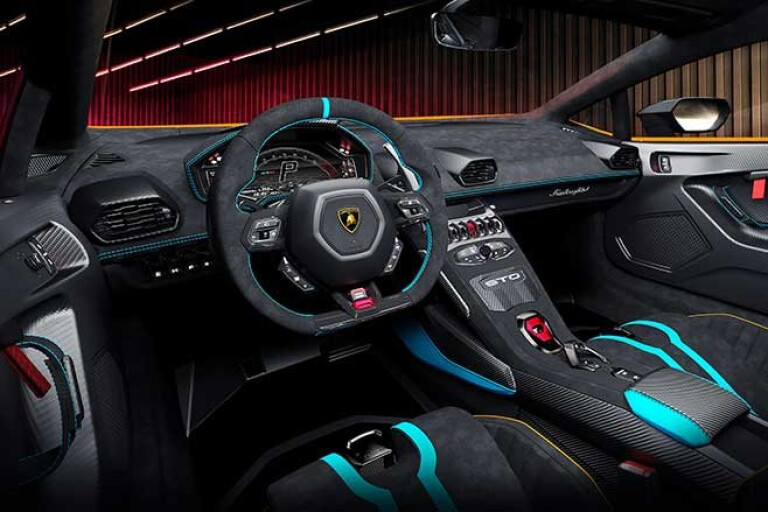
On the track
Phillip Island can be a jaw-clenching place in the wet and as I leave pitlane the words of chief test driver Milos are ringing in my ears: “This is the most aggressive car we have made so far. It moves around a lot at the rear.” Great.
Initially, though, the STO feels surprisingly approachable for a rear-drive supercar with 470kW. Part of that is down to the road-focused Bridgestones that help to clear water more effectively than Cup 2 rubber. And part of it is down to the STO’s new drive modes.
Drivers have three to choose from; STO, Trofeo and Pioggia. STO is the default mode, while Trofeo is designed for on-limit driving and slackens off the electronic stability aids. The ESC and traction control can be completely turned off separately.
Today, though, we’re using Pioggia mode. It’s the rain setting and it only takes a few corners to realise it’s excellent. Unlike other ‘wet’ modes that take away power and make the throttle feel soggy and lifeless, Pioggia’s focus seems to be on making you drive as quickly as possible in slippery conditions.
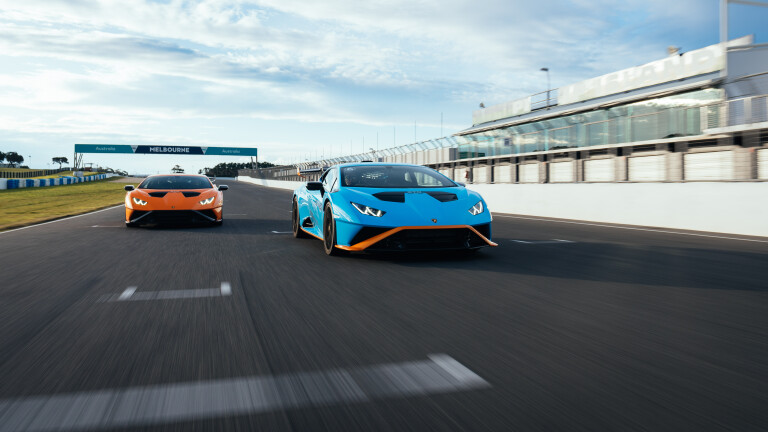
Lambo's big V10 is as potent as ever, the throttle response is razor sharp and it will also allow decent yaw angles before the ESC system gently intervenes to stop you from getting it really wrong.
The first session is so wet that the only valuable thing I learn is that the STO isn’t as spiky as other Huracan variants. Grip levels are clearly communicated and when you do encounter understeer or oversteer, the breakaway isn’t sudden. It’s a handful but a predictable one.
On a drying track, however, the STO starts to come alive. It’s still too slippy to engage Trofeo mode but with grip levels starting to rise, the deftness of the STO’s chassis tuning starts to become apparent. Front grip is immense, the firm brake pedal offers incredible confidence and stopping power and the steering is nicely weighted and accurate.
As well as ditching the front driveshafts, the STO uses a quicker fixed-ratio steering rack rather than the variable-ratio set-up on other Huracans and it’s all the better for it. Rear-wheel steering is also used to improve agility and stability but the system is so subtly integrated as to be virtually imperceptible.

The STO is an impressively agile and sensitive car to drive hard. Small adjustments to the throttle, steering or brakes are immediately felt and while we only just started to properly explore what the STO can do, it’s clear there’s genuine depth for owners to enjoy.
And that engine? We’re going to miss it once it’s gone. In a world of turbo rivals, the big V10 stands tall as a shining beacon of noise, response and power. The way it changes timbre above 4700rpm and screams all the way to 8500rpm is a genuine assault on your senses. It vibrates your ears and rattles your bones. It’s simply awesome.
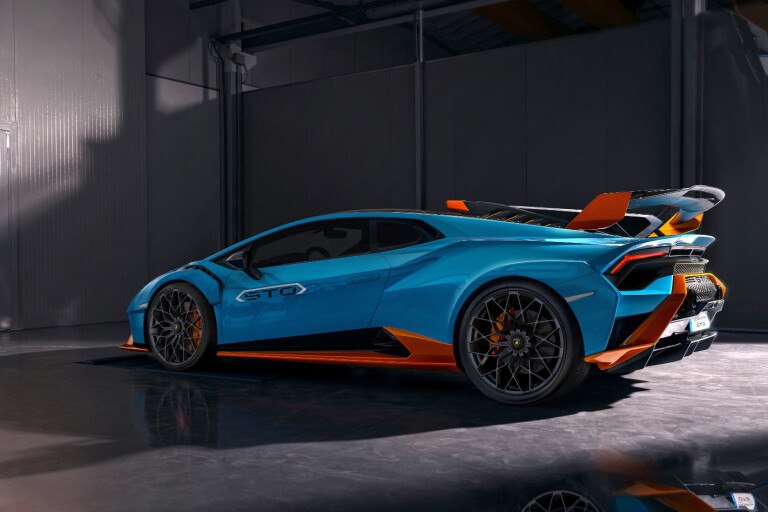
VERDICT
Are there faster and more capable track-focused supercars out there? Probably. Ferrari is no doubt already working on a lighter and more powerful version of the 296 GTB and it’s likely that car will be faster and even more capable than the Lambo.
That new Porsche GT3 RS I mentioned earlier? It has so much downforce and adjustable chassis tech that it should be significantly quicker than an STO against the clock. But weirdly for a track car, outright lap time isn’t the Lambo’s chief attraction. It’s how it feels.
Yes, there might be faster rivals out there but few can match the STO’s combination of visual drama, noise and sensations. It’s a proper event and while it’s also undoubtedly the fastest and most capable Huracan ever, the real stroke of genius is how the focus on lap times hasn’t been at the expense of engagement or fun.
A Lambo that’s just as capable to drive as it is as wild to look at? That’s a compelling recipe.
Score breakdown
Things we like
- Glorious, ear-drum-shattering V10
- Looks incredible
- The best-handling Huracan ever?
Not so much
- It’s sold out
- Focused chassis could be a handful on Aussie back roads
- Aussies miss out on excellent bucket seats



COMMENTS